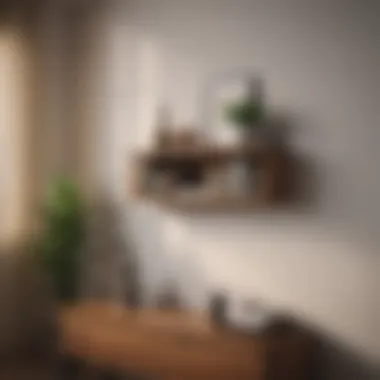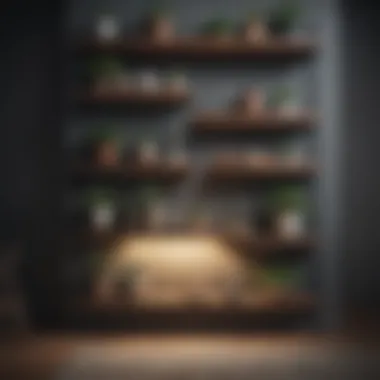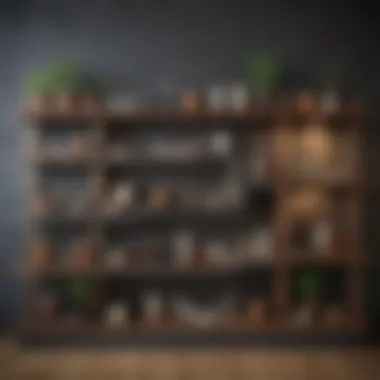Small Shelves in Living Rooms: Style & Function


Intro
Small shelves in a living room can perform many roles, balancing both aesthetic appeal and practical utility. They can highlight decorative items, showcase books, or provide space for various personal artifacts. The use of small shelves is not just a trend but a thoughtful approach to optimizing living environments.
Understanding how to select, place, and decorate small shelves requires research and creativity. This guide aims to explore the many facets of small shelves, guiding homeowners and design enthusiastic to make informed decisions for their unique spaces.
Understanding the Role of Shelves in Interior Design
Small shelves play a crucial role in interior design, particularly in living rooms where space optimization is needed. These functional elements contribute both practicality and beauty to any area. They serve as convenient storage solutions, accommodating various items such as books, decorative pieces, and plants. This dual purpose enhances the overall efficiency of the space while adding character.
Furthermore, shelves are versatile. They can fit into different styles, from modern minimalism to rustic charm. This versatility allows homeowners to tailor their living areas according to personal tastes and preferences. The importance of understanding how shelving integrates into a room cannot be underestimated. Good design requires considering how shelves interact with other furnishings and decor.
There are functional and aesthetic aspects to consider when selecting shelves.
The Functional Aspects of Shelves
Shelves provide essential storage solutions. They help to declutter surfaces, allowing for a more organized environment. Items can be displayed and easily accessed when shelves are used effectively. For instance, bookshelves can showcase literary collections, while corner shelves can utilize otherwise wasted space. The functionality of shelves is determined by their design, capacity, and placement.
The weight capacity is also important for functionality. Different materials can support varying weights, making it crucial to match the type of shelf with what it will hold. A shelf may have a beautiful design, but if it cannot hold its intended items, it becomes virtually useless. Therefore, knowing the load capacity before installation is key.
Aesthetic Benefits of Shelving
Aesthetically, shelving can enhance the beauty of a living room. They can act as a focal point or blend seamlessly with the decor. Open shelving, for example, allows homeowners to display items creatively, contributing to a feeling of openness in smaller rooms. Moreover, a shelf filled with carefully selected decor items or personal mementos adds a unique touch to the space.
The finish and style of the shelves—be it wood, metal, or glass—can drastically influence the room's overall decor theme. By coordinating the shelf design with existing furniture, homeowners can achieve visual harmony. A well-placed shelf can elevate a room's aesthetic, making it feel more polished and thoughtfully curated.
In summary, shelves are not merely functional; they are integral to the aesthetic composition of living spaces. Their role in organizing and beautifying a room makes them an essential element in interior design.
Types of Small Shelves for Living Room
Understanding the specific types of small shelves available for a living room is essential for any homeowner or interior design enthusiast. Each type serves unique functions, whether it be maximizing space, enhancing decor, or offering practical storage solutions. Selecting the appropriate shelf type can impact how the living area is perceived. Choosing wisely can optimize both the beauty and utility of the space.
Floating Shelves
Floating shelves are a popular choice in modern interior design. They offer a minimalist appearance by attaching directly to the wall without visible brackets. This creates an illusion of more space, making them ideal for smaller living rooms.
- Versatile Use: Floating shelves can display anything from books to decorative items. They can be stacked in various arrangements to create visual interest.
- Installation Ease: Most floating shelves are relatively easy to install. Many come with specific mounting hardware, which simplifies the process.
- Aesthetic Appeal: Their clean lines contribute to a sleek look. They work well in contemporary and traditional designs alike, enhancing the overall decor.
Corner Shelves
Corner shelves take advantage of typically unused spaces. They are especially valuable in smaller living rooms, as they utilize corners without encroaching on floor space.
- Space Efficiency: These shelves help store items without taking up too much room. It’s perfect for tight layouts.
- Design Variation: Corner shelves come in various styles, from triangular to rounded, allowing homeowners to find options that match their personal taste.
- Display Opportunities: They create unique display opportunities for decorative items or plants, adding dimension to the room.
Wall-Mounted Units
Wall-mounted units go beyond mere shelving. They often incorporate additional features like cabinets or hooks for further functionality.
- Comprehensive Solutions: Such units can be designed to combine workspace and organization, making them ideal for small living rooms that also function as home offices.
- Stylish Arrangements: Many models feature stylish designs that make them focal points in a room.
- Quality Construction: These units are usually sturdy, making them suitable for heavier objects, such as large books or electronics.
Freestanding Shelving
Freestanding shelves offer flexibility that other types may not. They can be moved and rearranged easily to fit any space.


- Adaptable Designs: Depending on the design, they can serve multiple functions, from storage to decorative displays.
- Stability and Support: Freestanding units are usually robust and can hold a significant weight, making them ideal for books or collectibles.
- Easy Integration: They can be easily integrated into any room layout without needing extra wall space. This is particularly useful in rental spaces where drilling into walls is not an option.
In summary, the choice of small shelves for a living room is vast. Each type contributes uniquely to both the functionality and aesthetic of the room. By understanding these options, homeowners can better assess their needs and make informed decisions.
Materials Used in Shelf Construction
The materials chosen for shelf construction play a vital role in both the functionality and aesthetic appeal of small shelves in the living room. A proper understanding of materials allows homeowners and design enthusiasts to select shelves that not only fit their decor style but also hold up under everyday use. The right material will determine the shelf’s durability, weight capacity, and maintenance requirements.
Shelving units made from various materials deliver distinct advantages, influencing the overall look of the space. When deciding on the type of shelf, it is essential to consider how the material will interact with existing furnishings. Additionally, the choice of material can reflect personal style and preferences, enhancing the overall interior design scheme.
Wooden Shelves
Wooden shelves are renowned for their warmth and versatility. They are available in numerous types, such as oak, pine, and walnut, each contributing a unique character to the living room.
- Durability: Quality wooden shelves can last for decades if maintained properly. They offer solid support for books and decorative items, appealing to those who appreciate sturdiness.
- Aesthetic Appeal: Wooden shelving adds a natural touch to the room. The grain patterns in wood can complement most styles, from rustic to contemporary.
- Customization: Wood can easily be stained or painted to match the color scheme of the living area, offering customization possibilities.
However, it is essential to also consider maintenance, as wooden shelves may require regular polishing or varnishing to prevent scratching or wear.
Metal Shelves
Metal shelves present a modern and industrial option for living rooms, favored for their rugged construction and sleek appearance.
- Strength: These shelves can handle a significant amount of weight, making them ideal for storing heavier items like books and decorative ceramics.
- Minimal Maintenance: Metal shelves generally require less upkeep compared to wood, as they are less prone to damage from moisture or insect infestations.
- Contemporary Style: Metal shelving often features clean lines and a minimalist aesthetic, appealing to those drawn to modern design.
Despite these attributes, metal shelves can sometimes be cold or uninviting, so it may be beneficial to incorporate warmer materials or decor elements to balance the look.
Glass Shelving
Glass shelving is a sophisticated choice that can create an airy feel in the living room. It works exceptionally well in small spaces, as it tends to blend seamlessly with the surroundings.
- Light Reflectivity: Glass shelves help to create an illusion of more space by reflecting light. This quality can brighten up darker corners of the room.
- Style Versatility: Glass can be paired with various frame materials, such as metal or wood, allowing for diverse design options.
- Easy to Clean: They require simple cleaning routines, as glass surfaces do not trap dust as easily as other materials.
However, one should bear in mind that glass shelves can be fragile and may not support as much weight as wooden or metal options, making it crucial to consider both design and practicality.
Choosing the Right Shelves for Your Space
Selecting the correct shelves for your living room is not just about filling empty wall space; it's a fundamental decision that can enhance both the functionality and aesthetic of your environment. The right shelves can significantly change how a room feels and operates, adding to both storage and style.
When dealing with small spaces, it’s crucial to choose shelves that complement the existing decor while serving practical purposes. Each element, like dimensions, style, and weight capacity, plays a role in ensuring your shelves are both functional and visually pleasing. This section provides a framework to make informed decisions, ensuring you select shelves that align with your necessities and taste.
Evaluating Room Dimensions
Before deciding on any shelving unit, assessing the dimensions of your room is vital. Understand the spatial limitations and opportunities your living room offers. Measure the available wall space, as well as the height and width where you plan to install or place shelves. This step helps avoid cumbersome designs that can overwhelm a small area.
A few key points to consider:
- Scale: Large, bulky shelves can dominate a small room, making it feel cramped. On the other hand, excessively thin shelves may not hold enough weight or items comfortably.
- Height: Think about the vertical space available. Higher shelves can draw the eye upward and create a sense of spaciousness. Utilize overhead areas but ensure they remain accessible.
- Feet Area: Freestanding units require floor space. Make sure they don't obstruct pathways or furniture.
Matching Shelves to Your Decor Style
The shelves you choose should resonate with your overall decor style. A mismatch can disrupt the visual harmony in your living space. There are several styles to consider when selecting shelves:
- Modern: Clean lines and minimalist design work well with contemporary spaces.
- Rustic: Reclaimed wood or distressed finishes can add warmth and character.
- Industrial: Metal and wood combinations can provide a trendy, urban feel.
Consider color coordination as well. Neutral tones can integrate well into various decor themes, while vibrant colors can serve as statement pieces. Ultimately, the right shelves should enhance the existing decor rather than overshadow it.


Considering Weight Capacity
Weight capacity cannot be overlooked when selecting shelves. Different materials have vastly different strength properties. Knowing what you intend to place on your shelves is crucial for choosing the right unit.
- Heavy Items: For books or collectibles, robust options like wood or metal are advisable, as they can support significant weight.
- Light Items: Glass or lighter materials may work well for decorative purposes but are not suitable for weighty items.
It's essential to check the manufacturer's specifications or guidelines for allowable weight limits. Failure to do so can result in unsafe conditions, potentially damaging both your items and the shelves themselves.
"Choosing the right shelves involves careful consideration of aesthetics and support capabilities. Avoid pitfalls by understanding your space thoroughly."
Effective Placement Strategies
The placement of small shelves in a living room holds significant importance in both functionality and aesthetics. Strategic placement not only enhances the visual appeal of the room but also facilitates practical use. Consider how light, balance, and space utilization impact the overall atmosphere. Properly placed shelves can accentuate key areas, create focal points, and ensure that every inch of the living area is optimized.
Illuminating Key Areas
Illumination is vital in making the best use of shelving. Shelves should be positioned to capture natural light, if possible. For instance, placing them near windows can enhance the display of items and contribute to a warm ambiance. Furthermore, consider adding LED strip lights on the underside of floating shelves. This would highlight your curated decor and ensure the items are easily visible without overwhelming brightness.
Creating Visual Balance
Visual balance is a principle that allows for the arrangement of shelves to create a sense of harmony. When positioning multiple shelves in a room, ensure they work together to create symmetry. For example, if you have a large shelf on one side of the room, balance it with a smaller shelf or other decorative elements on the opposite side. This creates contrast and draws the eye, making the space feel cohesive and intentional.
Maximizing Small Spaces
Maximizing small spaces is a challenge many homeowners face. Effective use of small shelves can help in this regard. When selecting locations for shelves, consider corners or areas above furniture, like sofas or chairs. Floating shelves are particularly advantageous because they do not take up floor space and can be installed at various heights. Using vertical space is essential; tall shelves can add storage without consuming much area. Another technique is to integrate shelves into other furniture, such as bookshelves or display cabinets, to minimize clutter and maintain organization.
Decorative Uses of Small Shelves
Small shelves in the living room serve various decorative purposes that enhance the overall design. They not only offer a practical solution for storage but also function as a canvas for personal expression. By selecting specific items to display on these shelves, homeowners can create a atmosphere that reflects their personalities and interests. It is this duality of function and art that makes small shelves vital in a well-designed living room.
Showcasing Books
Using small shelves to showcase books is a popular and effective method. It provides an opportunity to highlight literary collections and create a mini library atmosphere. Arranging books vertically or horizontally can add visual interest. Consider grouping books by color or theme to enhance aesthetic appeal. Add small decorative objects between the books to break the monotony and inspire curiosity.
This method is particularly beneficial for those who wish to promote reading and thoughtfulness within their households. It also allows easy access for family members or guests who might be interested in picking up a book.
Displaying Collectibles
Small shelves are ideal for displaying collectibles that share significance with the owner. Whether it is vintage toys, art pieces, or travel souvenirs, these items can tell a story. Arrange collectibles thoughtfully, making sure each piece can shine. Avoid overcrowding, as this can distract from individual items. Use different levels to create layers in the display, providing depth and engagement.
A well-organized display of cherished items invites conversation and nostalgia. Ensure that each item is secured properly, especially if they are valuable or fragile.
Arranging Plants
Incorporating plants into small shelves adds a refreshing touch to any living room. Plants not only purify the air but also bring life to the space. Choose low-maintenance species, suitable for indoor conditions like succulents or snake plants. Display them in unique pots to enhance their presence. You can also create a small indoor garden by clustering various plants together.
Arranging plants on small shelves encourages a connection with nature. It brings an organic element to the living room decor. Consider the lighting when selecting plant placements, as this will affect their growth and longevity.
In summary, small shelves bring together practicality and creativity. By showcasing books, displaying collectibles, and arranging plants, they can transform living spaces and highlight personal taste.
Maintaining and Organizing Shelves
Maintaining and organizing shelves is essential for ensuring that they serve their purpose effectively. When shelves are well-managed, they enhance the overall aesthetic of the living room while providing functional storage solutions. Cluttered or disorganized shelves can detract from the charm of any living space, making it feel chaotic and cramped. Regular maintenance helps in maximizing space and showcasing decorative items or books appropriately. This practice also aids in preserving the materials the shelves are made of, prolonging their lifespan.


Regular Cleaning Practices
Regular cleaning is crucial for the upkeep of shelves. Dust can accumulate quickly, especially in living rooms where windows are often open. A dusty shelf not only looks unattractive but can also affect the quality of items displayed. To maintain clean shelves, consider the following practices:
- Schedule Cleaning: Set a regular cleaning schedule, such as once a month, to dust and wipe down the shelves.
- Use Appropriate Tools: Utilize a soft cloth or microfiber cloth that can effectively trap dust without scratching the surface.
- Cleaning Solutions: Depending on the material, you might need mild soapy water for wooden shelves or glass cleaner for glass shelving.
- Check Items: During cleaning, check items on the shelves. Remove items that no longer fit your decor or are no longer needed. This will prevent clutter buildup.
By adhering to these practices, your shelves will always look presentable and inviting.
Organizational Techniques
Effective organization enhances both the functionality and visual appeal of your shelves. Here are some techniques that can make a significant difference:
- Categorize Items: Group similar items together. For example, place all books in one section and decorative items in another. This makes it easier to find what you need quickly.
- Use Baskets or Boxes: Incorporate storage baskets or decorative boxes to hold smaller items. This not only keeps items organized but also adds a design element to your shelves.
- Varying Heights: Arrange items of varying heights to create visual interest. Place taller items like vases on one side and shorter items like picture frames on the other.
- Create Focal Points: Highlight particular items that you want to showcase. This can be a prized collection or an art piece. Having distinct focal points draws attention and adds character to the shelf.
Implementing these organizational techniques will help maintain order on your shelves while ensuring they remain an attractive feature in your living room.
Innovative DIY Small Shelves
Creating small shelves through DIY methods offers several benefits, particularly in living room design. First, it allows for customization based on personal needs and space constraints. Homeowners can design shelves that fit specific dimensions, ensuring that every inch of available wall space is utilized effectively. Moreover, DIY shelves often convey a sense of individual style that store-bought options might lack, reflecting the unique personality of the homeowner.
Repurposing materials is another significant aspect of DIY shelving. It encourages sustainability and creativity. Instead of purchasing new materials, individuals can use leftover wood, metal, or even old furniture. This not only reduces waste but also produces unique, character-filled pieces that stand out in any living space.
"DIY Small Shelves not only enhance functionality but also imbue spaces with a sense of personal touch."
Additionally, the cost-effectiveness of DIY projects is appealing. With minimal investment, individuals can create shelves that would otherwise be expensive to buy. This is particularly beneficial for those on a budget or for those who appreciate the value of craftsmanship.
Repurposing Materials
Repurposing is a core element of creating unique DIY shelves. It invites creativity and resourcefulness. For instance, using reclaimed wood from old pallets or crafting shelves from discarded doors can result in stunning and functional pieces. Materials can be found nearly everywhere—at garage sales, flea markets, or even within one's own home.
Some key advantages of repurposing materials include:
- Sustainability: Reduces the demand for new resources and product waste.
- Cost-Effective: Often, salvaged materials can be obtained for little to no cost.
- Character: Each piece carries its own history, adding depth and story to your home décor.
Furthermore, when repurposing, it is crucial to assess the strength and durability of the materials to ensure they will support the weight of items placed on the shelves.
Custom Sizes and Designs
Custom sizes and designs are another compelling facet of innovative DIY small shelves. This aspect caters to the specific spatial needs of a living room while providing a tailored aesthetic. Homeowners can create units that perfectly match their existing furniture and decor, leading to a harmonious overall appearance.
To create a customized shelf:
- Measure Your Space: Understand the exact dimensions available in your living room. This ensures that the finished shelf will fit perfectly.
- Plan Your Design: Sketch out the shelf layout, considering factors like how many tiers you want and the heights for display items.
- Choose Materials Wisely: Select materials that suit your design preference—wood for a rustic look or metal for a modern touch.
- Finish and Assemble: Decide on paint or stain to enhance the appearance, followed by solid assembly to ensure stability.
Overall, opting for custom sizes allows homeowners to maximize functionality while incorporating personal style into their living rooms. By focusing on innovative DIY approaches, small shelves can become a practical and stylish solution, meeting both aesthetic and functional needs.
Trends in Small Shelving Solutions
The relevance of small shelving solutions is rising in modern interior design. Homeowners and decorators are increasingly focused on how shelving units can effectively utilize space while contributing to aesthetics. Trends in small shelving reflect a blend of style, sustainability, and functionality. Understanding these trends aids in making educated choices about integration in living spaces.
One notable trend is the shift towards sustainable shelving practices. This concept encompasses not only the materials used but also the overall design philosophy. Many homeowners prioritize eco-friendly options. They seek out shelving made from reclaimed wood or recycled materials, mindful of the environmental impact their furniture choices have. Such practices not only reduce the carbon footprint but also enhance the character of the space. Sustainable shelving often exhibits a unique charm, as each piece tells its own story through textures and grains.
Another crucial trend is the incorporation of smart shelving options. As technology advances, so do furniture solutions. Homeowners are embracing shelves equipped with technology—think of chargers built into shelf bases or LED lighting integrated into the design. These innovations cater to the modern lifestyle, merging convenience with decor. Thus, the emphasis on smart shelving reflects a broader trend toward multifunctional furniture that does not compromise on aesthetic appeal.
"In the quest for practicality, the latest trends in small shelving provide an opportunity for homeowners to express their personality while ensuring efficiency."
Benefits of Observing Trends in Small Shelving Solutions
- Creativity and Personalization: Staying informed about current trends allows for personalized designs that resonate with individual tastes.
- Improved Space Utilization: Trendy designs often prioritize compactness, enhancing living space utility without clutter.
- Aesthetic Appeal: Incorporating trending elements enhances the overall look, creating a stunning visual impact.
These considerations underline the importance of being attuned to trends in small shelving solutions. Homeowners can thereby make informed decisions that enhance both the functionality and beauty of their living room, ultimately reflecting their style and values.



